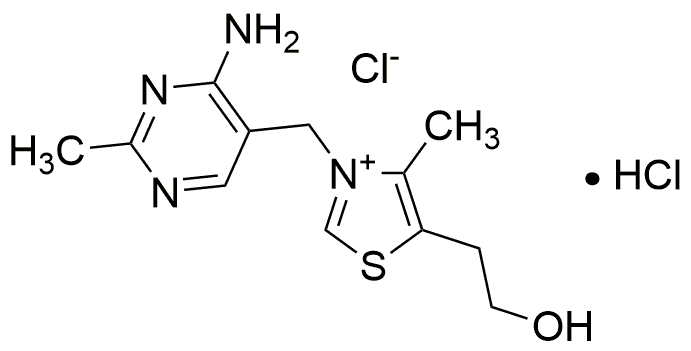Thiamine hydrochloride is widely utilized in research focused on:
- Nutritional Supplements: Commonly found in dietary supplements to prevent or treat thiamine deficiency, especially in populations at risk, such as those with alcohol dependence or certain medical conditions.
- Animal Feed Additives: Used in livestock feed to promote growth and improve overall health, enhancing the nutritional profile of animal diets and supporting better meat and milk production.
- Pharmaceuticals: Incorporated in various medications aimed at treating neurological disorders, as thiamine plays a crucial role in nerve function and energy metabolism.
- Food Fortification: Added to processed foods and beverages to enrich them with essential vitamins, helping to combat deficiencies in the general population, particularly in developing countries.
- Research Applications: Employed in laboratory studies to investigate metabolic pathways and the effects of vitamin B1 on cellular functions, providing insights into its role in health and disease.
General Information
Properties
Safety and Regulations
Applications
Thiamine hydrochloride is widely utilized in research focused on:
- Nutritional Supplements: Commonly found in dietary supplements to prevent or treat thiamine deficiency, especially in populations at risk, such as those with alcohol dependence or certain medical conditions.
- Animal Feed Additives: Used in livestock feed to promote growth and improve overall health, enhancing the nutritional profile of animal diets and supporting better meat and milk production.
- Pharmaceuticals: Incorporated in various medications aimed at treating neurological disorders, as thiamine plays a crucial role in nerve function and energy metabolism.
- Food Fortification: Added to processed foods and beverages to enrich them with essential vitamins, helping to combat deficiencies in the general population, particularly in developing countries.
- Research Applications: Employed in laboratory studies to investigate metabolic pathways and the effects of vitamin B1 on cellular functions, providing insights into its role in health and disease.
Documents
Safety Data Sheets (SDS)
The SDS provides comprehensive safety information on handling, storage, and disposal of the product.
Product Specification (PS)
The PS provides a comprehensive breakdown of the product’s properties, including chemical composition, physical state, purity, and storage requirements. It also details acceptable quality ranges and the product's intended applications.
Certificates of Analysis (COA)
Search for Certificates of Analysis (COA) by entering the products Lot Number. Lot and Batch Numbers can be found on a product’s label following the words ‘Lot’ or ‘Batch’.
*Catalog Number
*Lot Number
Certificates Of Origin (COO)
This COO confirms the country where the product was manufactured, and also details the materials and components used in it and whether it is derived from natural, synthetic, or other specific sources. This certificate may be required for customs, trade, and regulatory compliance.
*Catalog Number
*Lot Number
Safety Data Sheets (SDS)
The SDS provides comprehensive safety information on handling, storage, and disposal of the product.
DownloadProduct Specification (PS)
The PS provides a comprehensive breakdown of the product’s properties, including chemical composition, physical state, purity, and storage requirements. It also details acceptable quality ranges and the product's intended applications.
DownloadCertificates of Analysis (COA)
Search for Certificates of Analysis (COA) by entering the products Lot Number. Lot and Batch Numbers can be found on a product’s label following the words ‘Lot’ or ‘Batch’.
*Catalog Number
*Lot Number
Certificates Of Origin (COO)
This COO confirms the country where the product was manufactured, and also details the materials and components used in it and whether it is derived from natural, synthetic, or other specific sources. This certificate may be required for customs, trade, and regulatory compliance.


